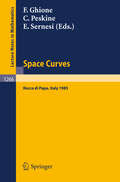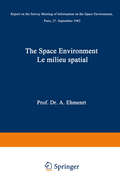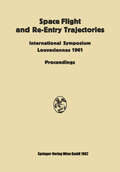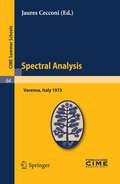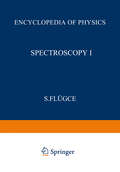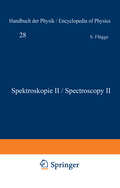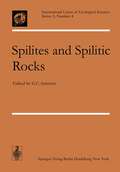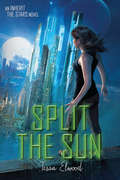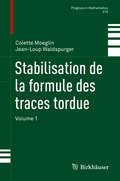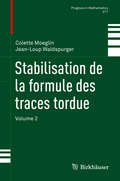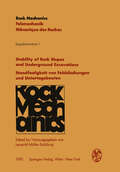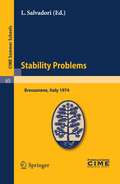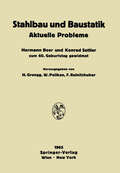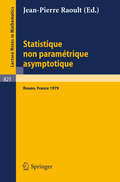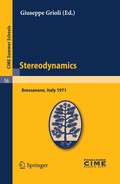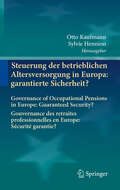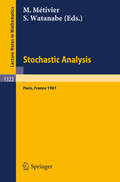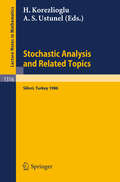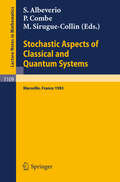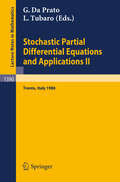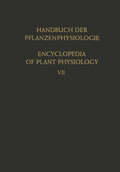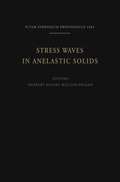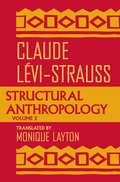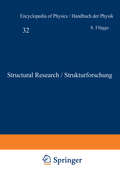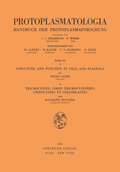- Table View
- List View
Space Curves: Proceedings of a Conference held in Rocca di Papa, Italy, June 3-8, 1985 (Lecture Notes in Mathematics #1266)
by Franco Ghione Christian Peskine Edoardo SernesiThe main topics of the conference on "Curves in Projective Space" were good and bad families of projective curves, postulation of projective space curves and classical problems in enumerative geometry.
The Space Environment / Le Milieu Spatial: Report on the Survey Meeting of Information on the Space Environment Paris, 27 September 1963
by Alfred EhmertOrganized by the International Academy of Astronautics and the International Astronautical Federation with the Support and Cooperation of UNESCO and the Scientific Cooperation of COSPAR
Space Flight and Re-Entry Trajectories: International Symposium Organized by the International Academy of Astronautics of the IAF Louveciennes, 19–21 June 1961 Proceedings
by Paul A. LibbyIn this and a following issue (Vol. VIII, 1962, Fasc. 2-3) of "Astronautica Acta" there will appear the papers presented at the first international symposium sponsored by the International Academy of Astronautics of the International Astronautical Federation. The theme of the meeting was "Space Flight and Re-Entry Trajectories." It was held at Louveciennes outside of Paris on June 19-21, 1961. Sixteen papers by authors from nine countries were presented; attendees numbered from 80 to 100. The organizing committee for the symposium was as follows: Prof. PAUL A. LIBBY, Polytechnic Institute of Brooklyn, U.S.A., Chairman; Prof. LuiGI BROGLIO, University of Rome, Italy; Prof. B. FRAEIJS DE VEUBEKE, University of Liege, Belgium; Dr. D. G. KING-HELE, Royal Aircraft Establishment, Farnborough, Rants, United Kingdom; Prof. J. M. J. KooY, Royal Military School, Breda, Netherlands; Prof. JEAN KovALEVSKY, Bureau des Longitudes, Paris, France; Prof. RuDOLF PESEK, Academy of Sciences, Prague, Czechoslovakia. The detailed arrangements for the meeting were made in a most satisfactory manner by Dr. FRANK J. MALINA, Deputy Director of IAA and Mr. A. R. WEILLER, Acting Secretary of IAA. Prof. THEODORE VON KARMAN, Director of IAA, in his remarks closing the symposium indicated his satisfaction at the interest being shown in "the science of the future." The papers which follow will make a permanent contribution to the literature of this science.
Spectral Analysis: Lectures given at a Summer School of the Centro Internazionale Matematico Estivo (C.I.M.E.) held in Varenna (Como), Italy, August 24-September 2, 1973 (C.I.M.E. Summer Schools #64)
by Jaures CecconiG. Bottaro: Quelques résultats d’analyse spectrale pour des opérateurs différentiels à coefficients constants sur des domaines non bornés.- L. Gårding: Eigenfuction expansions.- C. Goulaouic: Valeurs propres de problèmes aux limites irréguliers: applications.- G. Grubb: Essential spectra of elliptic systems on compact manifolds.- J.Cl. Guillot: Quelques résultats récents en Scattering.- N. Schechter: Theory of perturbations of partial differential operators.- C.H. Wilcox: Spectral analysis of the Laplacian with a discontinuous coefficient.
Spektroskopie II / Spectroscopy II (Handbuch der Physik Encyclopedia of Physics #5 / 28)
by S. FlüggeSpilites and Spilitic Rocks (International Union of Geological Sciences #4)
by G. C. AmstutzThe idea for the present Spilite Volume was born during the Spilite Symposium at the XXIIIrd session of the International Geological Con gress in Prague, 1968. At that time, only a restricted number of petro logists working on spilites was present and, therefore, the group assem bled agreed that a Symposium Volume should also include recent papers by many other spilite specialists. At the same time it was agreed that the papers presented at the Symposium should be returned to the authors for changes and additions. This procedure of upgrading and amending the papers has continued until this year (1973) for various technical and editorial reasons. The information presented here is, therefore, up-to date. To those familiar with the spilite problem it is obvious that the time had come for a review of its state. Also, the existing litera ture had become so voluminous that a monographic review was necessary. Following a modern trend, the authorship for this review was spread among specialists with variable experience. For readers not necessarily familiar with the spilite problem, a brief summary is presented here. A short historical note is followed first by the observations, then by the interpretations, finally by some of the major features of scientific logic as they pertain to the problem of the primary or secondary origin of some of the rocks termed spilites and keratophyres.
Split the Sun: An Inherit The Stars Novel
by Tessa ElwoodThe Ruling Lord of the House of Galton is dead and the nation is divided. Kit Franks, a nobody escalated to infamy since her mother bombed the House capitol city, wishes she were dead, too. Then Mom-the-terrorist starts showing up on feeds and causing planet-wide blackouts and Kit becomes a target. Kit's inundated with half-truths, betrayals, and the coded subtext in Mom's universal feed messages meant for her alone. Everyone from family to government enforcers seems to have a vision for Kit's future. The question is, does Kit have a vision for herself?
Stabilisation de la formule des traces tordue: Volume 1 (Progress in Mathematics #316)
by Colette Moeglin Jean-Loup WaldspurgerCe travail en deux volumes donne la preuve de la stabilisation de la formule des trace tordue.Stabiliser la formule des traces tordue est la méthode la plus puissante connue actuellement pour comprendre l'action naturelle du groupe des points adéliques d'un groupe réductif, tordue par un automorphisme, sur les formes automorphes de carré intégrable de ce groupe. Cette compréhension se fait en réduisant le problème, suivant les idées de Langlands, à des groupes plus petits munis d'un certain nombre de données auxiliaires; c'est ce que l'on appelle les données endoscopiques. L'analogue non tordu a été résolu par J. Arthur et dans ce livre on suit la stratégie de celui-ci.Publier ce travail sous forme de livre permet de le rendre le plus complet possible. Les auteurs ont repris la théorie de l'endoscopie tordue développée par R. Kottwitz et D. Shelstad et par J.-P. Labesse. Ils donnent tous les arguments des démonstrations même si nombre d'entre eux se trouvent déjà dans les travaux d'Arthur concernant le cas de la formule des traces non tordue.Ce travail permet de rendre inconditionnelle la classification que J. Arthur a donnée des formes automorphes de carré intégrable pour les groupes classiques quasi-déployés, c’était pour les auteurs une des principales motivations pour l’écrire.Cette première partie comprend les chapitres préparatoires (I-V).
Stabilisation de la formule des traces tordue: Volume 2 (Progress in Mathematics #317)
by Colette Moeglin Jean-Loup WaldspurgerCe travail en deux volumes donne la preuve de la stabilisation de la formule des trace tordue. Stabiliser la formule des traces tordue est la méthode la plus puissante connue actuellement pour comprendre l'action naturelle du groupe des points adéliques d'un groupe réductif, tordue par un automorphisme, sur les formes automorphes de carré intégrable de ce groupe. Cette compréhension se fait en réduisant le problème, suivant les idées de Langlands, à des groupes plus petits munis d'un certain nombre de données auxiliaires; c'est ce que l'on appelle les données endoscopiques. L'analogue non tordu a été résolu par J. Arthur et dans ce livre on suit la stratégie de celui-ci. Publier ce travail sous forme de livre permet de le rendre le plus complet possible. Les auteurs ont repris la théorie de l'endoscopie tordue développée par R. Kottwitz et D. Shelstad et par J.-P. Labesse. Ils donnent tous les arguments des démonstrations même si nombre d'entre eux se trouvent déjà dans les travaux d'Arthur concernant le cas de la formule des traces non tordue. Ce travail permet de rendre inconditionnelle la classification que J. Arthur a donnée des formes automorphes de carré intégrable pour les groupes classiques quasi-déployés, c’était pour les auteurs une des principales motivations pour l’écrire. Cette partie contient les preuves de la stabilisation géométrique et de la partie spectrale en particulier de la partie discrète de ce terme, ce qui est le point d'aboutissement de ce sujet.
Stability of Rock Slopes and Underground Excavations / Standfestigkeit von Felsböschungen und Untertagebauten: Contributions to the Josef-Stini-Colloquium (18th Geomechanical Colloquium) of the Austrian Society for Geomechanics / Vorträge des Josef-Stini-Kolloquiums (18. Geomechanik-Kolloquium) der Österreichischen Gesellschaft für Geomechanik (Rock Mechanics Felsmechanik Mecanique des roches. Supplementa #1)
by Leopold MüllerStability Problems: Lectures given at a Summer School of the Centro Internazionale Matematico Estivo (C.I.M.E.) held in Bressanone (Bolzano), Italy, June 2-11, 1974 (C.I.M.E. Summer Schools #65)
by L. SalvadoriP. Habets: Stabilité asymptotique pour des problèmes de perturbations singulières.- J.K. Hale: Stability of linear systems with delays.- V. Lakshmikantham: Stability and asymptotic behaviour of solutions of differential equations in a Banach space.- P. Negrini: On a definition of total stability for continuous or discrete dynamical systems.-N. Rouche: Théorie de la stabilité dans les équations différentielles ordinaires.- E.O. Roxin: Stability and differential games.
Stahlbau und Baustatik: Aktuelle Probleme
by Hermann Grengg Walter Pelikan F. ReinitzhuberHermann Beer und Konrad Sattler zum 60. Geburtstag gewidmet
Statistique non Parametrique Asymptotique: Actes des Journees Statistiques, Rouen, France, Juin 1979 (Lecture Notes in Mathematics #821)
by J. P. RaoultStereodynamics: Lectures given at a Summer School of the Centro Internazionale Matematico Estivo (C.I.M.E.) held in Bressanone (Bolzano), Italy, June 2-12, 1971 (C.I.M.E. Summer Schools #56)
by Giuseppe GrioliG. Grioli: Particular solutions in stereodynamics.- P. Hagedorn: On the converse of the Lagrange-Dirichlet stability theorem.- M. Langlois: Contribution à l’étude du mouvement du corps rigide à n dimensions autour d’un point fixe.- E. Leimanis: Some recent results concerning the motion of a rigid body about a fixed point.- H. Price: A canonical form of Euler’s equations and a method of solutions for arbitrary applied couples.- V.V. Rumyentsev: Dynamics and stability of rigid bodies.- J. Wittenburg: The dynamics of systems of coupled rigid bodies. A new general formalism with applications.
Steuerung der betrieblichen Altersversorgung in Europa: Governance of Occupational Pensions in Europe: Guaranteed Security? Gouvernance des retraites professionnelles en Europe: Sécurité garantie?
by Otto Kaufmann and Sylvie HennionNahezu alle europäischen Staaten haben ihre Alterssicherungssysteme reformiert mit dem Ziel, sie zu konsolidieren. Die betriebliche Altersversorgung ist seitdem zu einem Schwerpunkt betrieblicher Sozialpolitik geworden. Bei der Errichtung, Durchführung und der Kontrolle betrieblicher Altersversorgungssysteme stellen sich zahlreiche Rechtsfragen. In dem Werk wird das Zusammenwirken der Sozialpartner analysiert. Es wird aufgezeigt, welche Handlungsspielräume bestehen und welche Kontroll- und Entscheidungskompetenzen jeweils eingeräumt werden.
Stochastic Analysis: Proceedings of the Japanese-French Seminar held in Paris, France, June 16-19, 1987 (Lecture Notes in Mathematics #1322)
by Michel Metivier Shinzo WatanabeStochastic Analysis and Related Topics: Proceedings of a Workshop held in Silivri, Turkey, July 7–9, 1986 (Lecture Notes in Mathematics #1316)
by Hayri Korezlioglu Ali S. UstunelThe Silvri Workshop was divided into a short summer school and a working conference, producing lectures and research papers on recent developments in stochastic analysis on Wiener space. The topics treated in the lectures relate to the Malliavin calculus, the Skorohod integral and nonlinear functionals of white noise. Most of the research papers are applications of these subjects. This volume addresses researchers and graduate students in stochastic processes and theoretical physics.
Stochastic Aspects of Classical and Quantum Systems: Proceedings of the 2nd French-German Encounter in Mathematics and Physics, held in Marseille, France, March 28 - April 1, 1983 (Lecture Notes in Mathematics #1109)
by S. Albeverio P. Combe M. Sirugue-CollinStochastic Partial Differential Equations and Applications II: Proceedings of a Conference held in Trento, Italy, February 1-6, 1988 (Lecture Notes in Mathematics #1390)
by Giuseppe Da Prato Luciano TubaroStoffwechselphysiologie der Fette und Fettähnlicher Stoffe / The Metabolism of Fats and Related Compounds (Handbuch der Pflanzenphysiologie Encyclopedia of Plant Physiology #7)
by M. SteinerStress Waves in Anelastic Solids: Symposium Held at Brown University, Providence, R. I., April 3–5, 1963 (IUTAM Symposia)
by Herbert Kolsky William PragerAlthough the subject of wave propagation in solids has a long history, the classical theory of elastic waves having been developed in the nine teenth century by STOKES, POISSON, RAYLEIGH and KELVIN, the last two decades have seen a remarkable revival of interest in this subject among both theoreticians and experimenters. There' are a number of reasons for this; first, experimental methods for the generation and detection of high frequency mechanical waves have become available only with the advent of electronic techniques and of high speed photo graphic recording apparatus. Secondly, the appearan
Structural Anthropology, Volume 2 (Peregrine Bks.)
by Claude Lévi-StraussThe eighteen essays collected in this volume have been selected and ordered to give what Lévi-Strauss terms "a bird's-eye view of the problems of modern ethnology." As representative examples, these essays introduce readers to the methods of structural anthropology while affording a glimpse into the mind of one of the foremost anthropologists of our time. "Structural Anthropology, Volume II is a diverse collection. [It is] a useful 'sampler' that gives a reader the full range of Lévi-Strauss's interests."—Daniel Bell, New York Times Book Review
Structural Research / Strukturforschung (Handbuch der Physik Encyclopedia of Physics #6 / 32)
by Dr. André Guinier Dr. Gérard Eller Dr. J. Bouman Dr. Gérard Fournet Professor Dr. Beeman Professor Dr. Kaesberg Dr. J. Anderegg Dr. M. Webb Professor Dr. Raether Dr. G. Ringo107 In this way the absolute values of the structure factors may be found, not the phases (6. 8). The problem to find these phases is the phase problem. The present article will treat the following topics. At first the description of the ideal crystal will be given in Chap. B. The underlying principles of this description are the concepts of reciprocal lattice, FOURIER synthesis and sym metry. The evaluation of the intensity will then follow in Chap. C and D. Chap. E is concerned with the phase problem and related topics. Though this article treats the analysis of crystal structures, the fundamental concepts for other structures will here be found too. But these topics, and the experimental methods, will l find their place elsewhere . B. Description of the crystalline state. I. Lattice theory. a) The direct lattice. 8. Introduction. In Sect. 3, a description of the ideal crystal was given: The space, occupied by a crystal, is divided into congruent parallelepipeds, each with the same orientation. This parallelepiped is defined by the three basic vectors, a, band c, drawn from an origin 0 (Fig. 2), and is called the primitive cell. This cell is filled with atoms (or ions), and the same configuration of atoms is repeated in space. It has been aptly called a three-dimensional wallpaper, as on a wallpaper the same pattern is repeated again and again.
